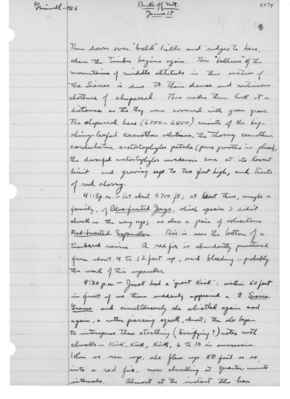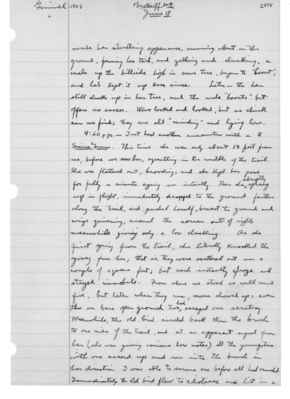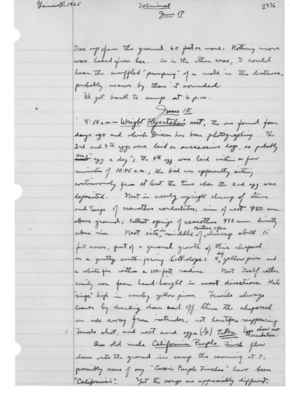Pages That Mention hill
1925: Joseph Grinnell's field notes
S2 Page 13
Collector: Grinnell - 1925 Location: Lassen Section (Mineral) Date: June 16, 1925 Page Number: 2469
feeding about our campsite. The male has frequently sung from a young fir tip scarcely ten feet directly above the nest, also from the brush all about it, and when hopping on the ground between or thru the bushes. The rim of the nest is 360 mm. above a mat of yellow pine needles; the nest itself is ensconced among the leaning stems of a rather sparse ceanothus integerrimus. It is a large structure, of much coarse pine and other twigs externally, and lined with shredded bark. There are two young, about 3 days old I think, helpless and downy rather than feathery. The old female is very solicitous, coming within 6 feet of us when at the nest; but the male shows little concern, and sings volubly immediately we leave, from within 20 feet of the nest. Mountain Chickadee's nest, with young, in woodpecker hole opening on under side of a leaning stub a foot in diameter and some 15 feet long. Entrance just my height from the ground - 5 ft., 7 in.; diameter of entrance, 44 mm. - so probably was made by a White-headed Woodpecker. Site open, surrounded by dry ceanothus slope; some very small yellow pines nearby, also two yellow pine stumps, sawed off so long ago they are rotting, cleft. The old chickadees come with food freely, altho I am only about 15 feet away under a bush on the dry (?) hill side. Each bird dives directly into the hole, as it arrives,
S2 Page 19
Collector: Grinnell - 1925 Location: Lassen Section (Brokeoff Mt.) Date: June 17, 1925 Page Number: 2474
Then down over "bald" hills and ridges to here, where the Timber begins again. This "baldness" of the mountains of middle altitude in this section of the Sierras is due to their dense and continuous clothure of chaparral. This makes them look at a distance as tho they were covered with green grass. The chaparral here (6000-6500) consists of the big shiny-leafed ceanothus velutinus, the thorny ceanothus condulatus, arctostaphylos patula (pure growths in places), the dwarfed arctostaphylos nevadensis here at its lowest limit and growing up to two feet high, and tracts of red cherry. 4:15 p.m. - At about 6700 ft.; at least there, maybe a family, of Blue-fronted Jays, which species I didn't check on the way up; as also a pair of solicitous Red-breasted Sapsuckers. This is near the bottom of a timbered ravine. A red fir is abundantly punctured from about 4 to 12 feet up, and bleeding - probably the work of this sapsucker. 4:30 p.m. - Just had a "great kick": within 50 feet in front of us there suddenly appeared a female Sierra Grouse and simultaneously she whistled again and again, a rather piercing squall, almost; then she began to intersperse these startling (terrifying?) notes with clucks - kirk, kirk, kirk, 6 to 10 in succession. When we ran up, she flew up 80 feet or so into a red fir, now clucking at quarter-minute intervals. Almost at the instant the hen
S2 Page 20
Author: Grinnell-1925 Location: Lassen Section (Brokeoff Mt.) Date: June 17, 1925 Page Number: 2475
made her startling appearance, running about on the ground, fanning her tail, and yelling and clucking, a male up the hillside high in some tree, began to "boont", and he's kept it up ever since. Later - the hen still clucks up in her tree, and the male "boonts" but offers his succor. We've looked and looked, but no chick can we find; they are all "(unknown2)" and lying low. 4:50 p.m. - Just had another encounter with a female Sierra Grouse. This time she was only about 12 feet from us, before we saw her, squatting in the middle of the trail. She was flattened out, brooding; and she kept her pose for fully a minute eyeing us intently. Then she abruptly sprung up in flight, immediately dropped to the ground farther along the trail, and pushed herself, breast to ground and wings quivering, around the corner out of sight, meanwhile giving only a low clucking. As she first sprung from the trail, she literally knocked the young from her; that is, they were scattered out over a couple of square feet; but each instantly froze, and stayed immobile. From where we stand we could count five, but later when they ran, seven showed up: even tho on bare open ground two had escaped our scrutiny. Meanwhile, the old bird circled back thru the brush to one side of the trail, and at at an apparent signal from her (she was giving various low notes) all the youngsters with one accord up and ran into the brush in her direction. I was able to secure one before all had vanished. Immediately the old bird flew to a distance and lit in a
S2 Page 21
Collector: Grinnell-1925 Location: Mineral Date: June 17 Page Number: 2476
tree up from the ground 60 feet or more. Nothing more was heard from her. As in the other case, I could hear the muffled "pumping" of a mile in the distance, probably nearer than it sounded.
We got back to camp at 6pm.
8:15 a.m -- Wright Flycatcher's nest, the one found four days ago and which Dixon has been photographing. The 3rd and 4th eggs were laid on successive lays, so probably an "egg a day"; the 4th egg was laid within a few minutes of 10:45 a.m.; the bird was apparently sitting continuously from at least the time when the 2nd egg was deposited. Nest in nearly upright clump of stems and twigs of Ceanothus cordulatus; rim of nest 950 mm. above ground; tallest sprigs of ceanothus 490 mm. directly above rim. Nest site in middle of rather open clump about 15 feet across, part of a general growth of this chaparral on a gently south-facing hill-slope; 4 big yellow pines and a white fir within a 100-foot radius. Nest itself rather easily seen from head-height in most directions. Male "sings" high in nearby yellow pines. Female always leaves by ducking down and off thru the chaparral on side away from intruder, not heretofore reappearing. Female shot, and nest and eggs (1/4) taken. Eggs show no incubation.
One old male California Purple Finch flew down onto the ground in camp this morning at 7; possibly some of my "Cassins Purple Finches" have been "California's". Yet the songs are appreciably different.
S2 Page 37
Collector: Grinnell - 1925 Location: Mineral Date: June 22 Page Number: 2491
Wright Flycatcher's nest, near camp (75 ft. uphill from), with 4 young hatched on 14th; found with opaque eggs two days previously by Dixon and, I think, photographed by him. Rim of nest 1500 mm. above ground, nest (of usual construction and gray color, ensconced among pendent twigs were [sic] a slender branch from each of two adjacent red cherry bushes one another, and one of these has an unhealthy outgrowth of leafage looking like mistletoe. Nest within to feet, one east side, of 24-inch trunk of yellow pine; snow bushes nearby, and firs within 20 feet; site practically where a tract of timber and a hillside tract of open snowbush adjoins. Male fed young at 3:12 and 3:16, he not being, apparently, alarmed at us, as is female which was brooding when we came. Female continues to utter a faint "peet" of concern; male from overhead says "see-put" (uttered very rapidly); when male alighted on edge of nest to feed, he gave a short musical trill of short duration and weak in volume. Female keeps close to nest, perching on twigs within a radius of 4 feet. She perches on edge of nest; leaves; returns and settles down to brood, continuing to say "peet", but more faintly. 3:30 - [female symbol] still brooding and saying "peet" very faintly and not so frequently. 3:35 - (female) still brooding, tho nest is in shade of pine trunk: has ceased to say "pit."




